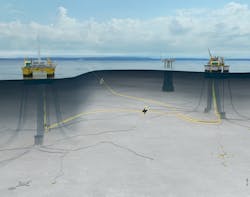Equinor, partners to extend electrification at North Sea Troll complex
Offshore staff
STAVANGER, Norway – Equinor has submitted a plan for electrification of Troll West in the North Sea to Norway’s Minister of Petroleum and Energy.
The proposed scheme calls for partial electrification of the Troll B platform and full electrification of Troll C, cutting CO2 emissions from the Troll field by close to half a million metric tons/yr, and NOx emissions by around 1,700 t annually.
Equinor and its partners in the Troll Unit, Petoro, Shell, Total and ConocoPhillips, estimate the capex at NOK7.9 billion ($950 million). And the Norwegian NOx fund has pledged NOK520 million ($62.5 million) of financial support.
Arne Sigve Nylund, Equinor’s evp for Technology, Projects & Drilling, said: “The temporary changes to the petroleum tax regime adopted by Parliament as a result of COVID-19 have enabled us to implement several of the projects planned prior to the pandemic.”
The subsea cable to the Troll B and C platforms will reach landfall at Kollsnes in Øygarden, west of Bergen. An HV subsea cable will run from Kollsnes to Troll B, with another between Troll B and Troll C.
Both platforms’ current power demand will be met from shore, and the two gas export compressors on Troll C – currently driven by gas turbines – will be replaced by electric motors.
In addition, the infrastructure at Kollsnes and cable to the platform will be designed for a possible future full electrification of Troll B.
The Troll A platform, which started operations in 1996, was Norway’s first electrified offshore installation.
Aker Solutions has a NOK2.9-billion ($348-million) EPCI contract to perform modifications that will allow the Troll B and C topsides to receive power from shore.
The company will manage the engineering from its Bergen office and the construction at its Stord yard.
Skanska will construct a new transformer substation, cable trenches and landfall at Kollsnes under a NOK390-million ($46.8-million) contract, spearheaded by the company’s construction division in Bergen.
NKT will fabricate and install the HV subsea cables under a NOK1-billion ($120-million) contract, with the cable manufactured in Karlskrona, Sweden, and the vessel NKT Victoria performing cable laying. Late last month the Ministry of Petroleum and Energy granted Equinor a concession to construct, own, and operate the electrical installations to supply the two Troll platforms with power from shore.
Troll B will be part-electrified in 1Q 2024, and Troll C fully electrified by 2Q 2026.
Equinor operates the Troll field from its operations organization at Sandsli in Bergen.
In addition, Equinor could electrify over 35% of its total oil and gas production base in Norway through power from shore by 2025, according to GlobalData.
Senior oil and gas analyst Daniel Rogers said: “By replacing traditional gas and diesel burning turbines for power generation and connecting to the Norwegian electricity grid, Norwegian operators can significantly curb their emissions.
“Of the active offshore electrification projects that Equinor is involved in, Troll and Johan Sverdrup have avoided the largest emission volumes through electrification at over 600,000 tons of CO2 per year each.
“Equinor is aggressively expanding its electrification efforts through the Utsira High project, which entails electrification of offshore fields Gina Krog, Edvard Grieg and Ivar Aasen, as well as partial electrification of Sleipner and Gudrun. The project is estimated to reduce emissions of over one million tons of CO2 per year.”
Elsewhere in Norway, Lundin Energy, while not producing volumes on the scale of Equinor, is on track to electrify over 90% of its total production base by 2025, Rogers claimed.
“While small local player OKEA currently has 50% of its production stream electrified, by 2025 the company could have an entirely electrified production base if announced electrification efforts go forward,” he added.
04/23/2021




